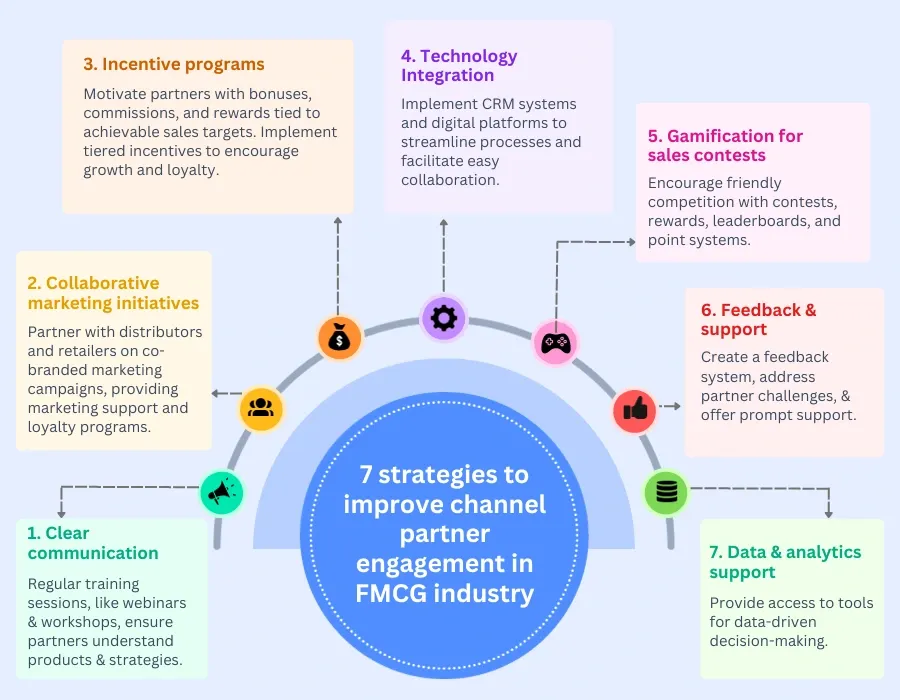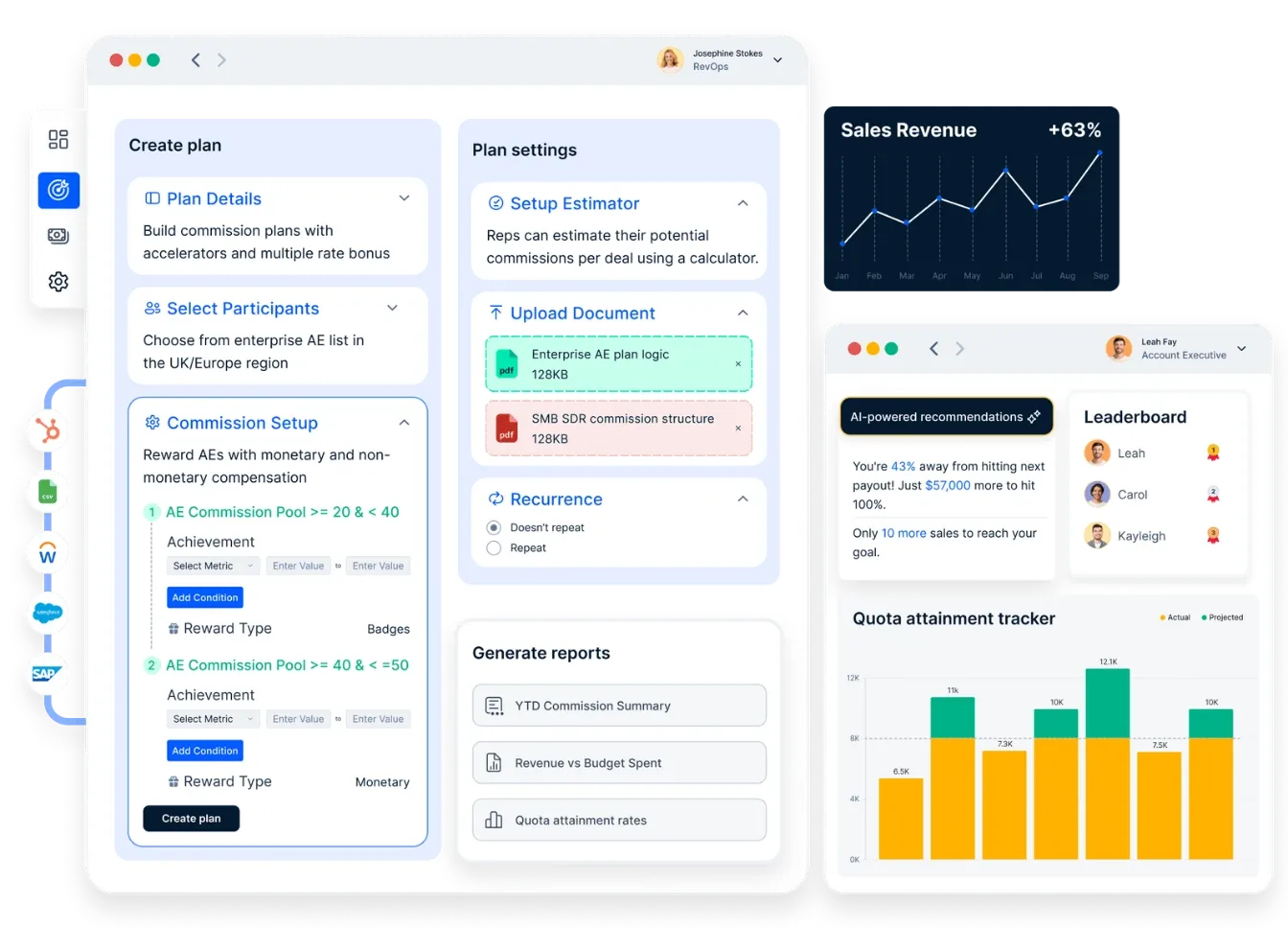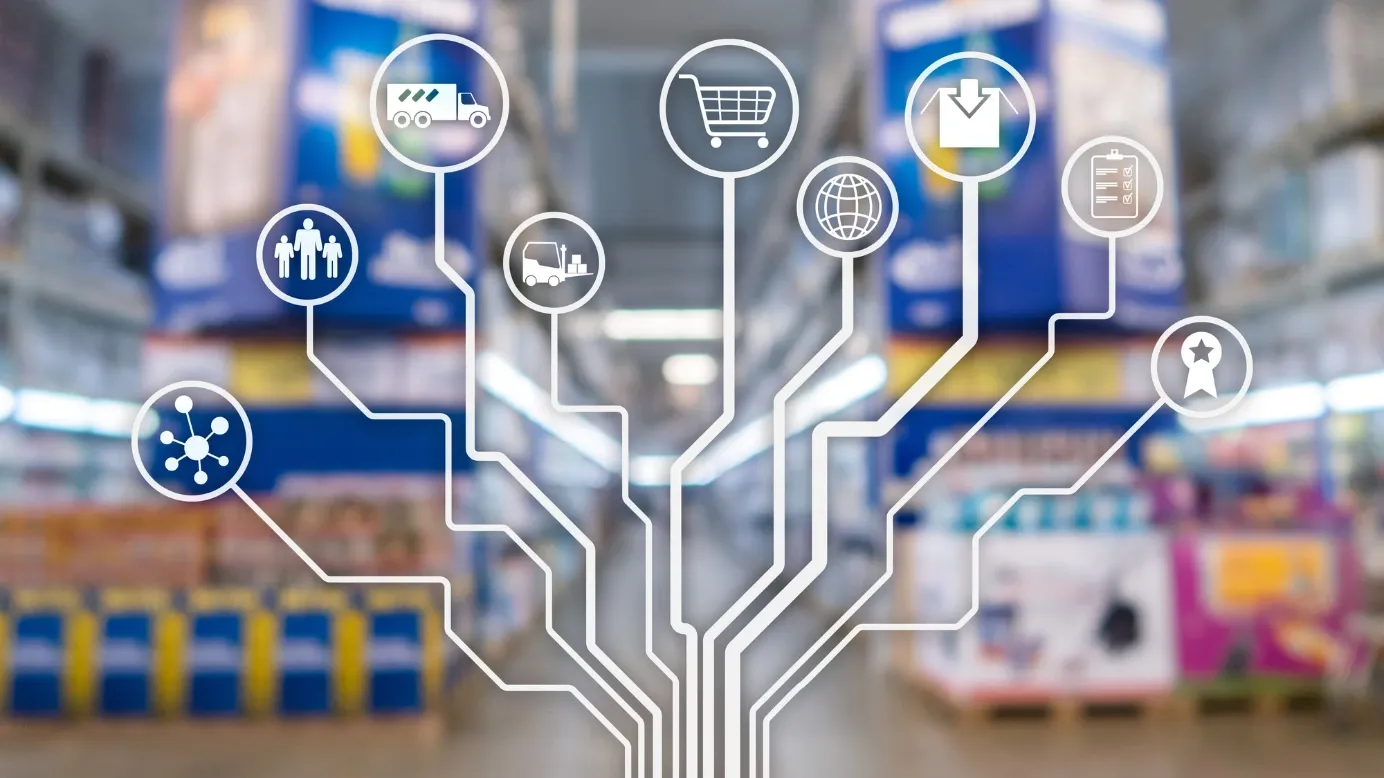7 Strategi Penglibatan Rakan Kongsi Saluran Berkesan dalam Industri FMCG
7 strategi penglibatan rakan kongsi saluran dalam industri FMCG. Ketahui amalan terbaik untuk meningkatkan jualan, meningkatkan komunikasi, dan memacu kejayaan dalam industri FMCG.
Pada halaman ini
Gambar ini: rak pasar raya penuh dengan makanan ringan kegemaran anda, produk penjagaan diri penting, dan minuman - semuanya tersedia, terima kasih kepada web pengedar, peruncit, dan pemborong yang kompleks yang bekerja tanpa mengenal penat lelah di belakang tabir. Rakan kongsi saluran adalah nadi industri FMCG, memastikan bahawa barangan pilihan anda berada dalam jangkauan lengan.
But here's the secret sauce that sets some FMCG companies apart from the rest – their channel partner engagement strategy. In today’s world, consumers expect convenience and variety, and competition is as fierce as ever. The key to success lies in forging unbreakable connections with those (channel partners) who bring your products to life on store shelves.
Lebih-lebih lagi, memotivasi dan menarik rakan kongsi saluran bukan lagi amalan terbaik - ia adalah satu keperluan.
And the outcomes of doing so are high yielding:
- Hasil #1: Mencapai asas pelanggan yang lebih luas dengan mengedarkan produk ke lokasi geografi yang pelbagai dan segmen pasaran
- Hasil #2: Membawa kepada jumlah jualan yang lebih tinggi sebagai rakan kongsi saluran secara aktif mempromosikan dan menjual produk FMCG, meningkatkan pendapatan
- Hasil #3: Kurangkan kos operasi yang berkaitan dengan pergudangan, logistik, dan pengurusan inventori, meningkatkan kecekapan kos
- Hasil #4: Berikan pandangan pasaran dan data pengguna yang berharga, membolehkan syarikat FMCG membuat keputusan termaklum dan menyesuaikan diri dengan perubahan pilihan pengguna.
Sekiranya anda memerlukan lebih meyakinkan, berikut adalah beberapa statistik menarik yang menggambarkan mengapa sekarang boleh menjadi masa yang sesuai untuk perniagaan anda mengemas kini strategi penglibatan rakan kongsi saluran anda.
👉 63.5% of the companies stated that channel partners contributed to their annual revenue and 24% of the surveyed organizations stated that it takes over a year for them to become fully productive. — CSO Insights
👉 36% Of companies say that the top 20% of their channel partners are generating over 70% of all channel revenues. — CGS
👉 Approximately one-third of businesses utilize a sales channel, yet only a portion of them have a successful channel partner engagement program in place. — Aberdeen
Oleh itu, mari kita menyelidiki beberapa strategi penglibatan rakan kongsi saluran yang paling menonjol dalam industri FMCG.
Tetapi sebelum kita meneroka nuansa penglibatan rakan kongsi saluran dalam industri FMCG, penting untuk menentukan apa yang diperlukan oleh istilah ini.
Memahami penglibatan rakan kongsi saluran dalam industri FMCG
Penglibatan rakan kongsi saluran merujuk kepada hubungan kolaboratif dan saling menguntungkan antara pengeluar FMCG dan pelbagai rakan kongsi saluran dalam mengedarkan dan menjual produk mereka. Rakan kongsi saluran ini biasanya termasuk pengedar, peruncit, pemborong, dan platform e-dagang.
Kerjasama ini penting kerana beberapa sebab:
- Pengedaran yang luas: Produk FMCG perlu mencapai asas pelanggan yang luas dan pelbagai. Rakan kongsi saluran membantu pengeluar mengedarkan produk dengan cekap, memastikan ia dapat diakses oleh pengguna di pelbagai wilayah.
- Penembusan pasaran: Syarikat FMCG sering bergantung kepada rakan kongsi saluran untuk menembusi pasaran tempatan dengan berkesan, kerana rakan kongsi ini mempunyai pemahaman yang mendalam tentang pilihan pelanggan tempatan dan tingkah laku pembelian.
- Kecekapan kos: Kerjasama dengan rakan kongsi saluran membolehkan pengeluar FMCG meminimumkan kos operasi yang berkaitan dengan pergudangan, pengangkutan, dan pengurusan inventori.
- Customer Insights: Channel partners are often the closest touchpoint to consumers, providing valuable insights into changing consumer preferences and market trends.
Walaupun rakan kongsi saluran memainkan peranan penting dalam industri FMCG, mereka terus menghadapi pelbagai cabaran, penyelesaian yang penting untuk kejayaan keseluruhan perniagaan.
Cabaran yang memberi kesan kepada prestasi rakan kongsi Saluran dan keuntungan perniagaan
Berikut adalah 3 cabaran yang paling biasa dan diabaikan yang memberi kesan kepada prestasi rakan kongsi saluran dan keuntungan perniagaan.
1. Pemisahan rakan kongsi
Rakan kongsi saluran mungkin mempunyai banyak hubungan vendor, menjadikannya sukar untuk memastikan mereka terlibat dan komited terhadap produk atau perkhidmatan anda. Ini boleh menyebabkan jualan berkurangan dan memberi kesan negatif kepada garis bawah.
Jika rakan kongsi saluran tidak dimaklumkan dengan baik tentang kemas kini produk anda, strategi pemasaran, atau sasaran jualan, mereka mungkin tidak menyelaraskan usaha mereka dengan matlamat perniagaan anda, yang membawa kepada prestasi dan penjualan yang berkurangan.
How to deal with this: Frequent and transparent communication with your channel partners is crucial. By keeping them informed about product updates, marketing initiatives, and industry trends, you can foster a sense of engagement and involvement.
2. Kurang ketelusan prestasi
Tanpa data masa nyata mengenai prestasi rakan kongsi, adalah mencabar untuk mengenal pasti rakan kongsi yang kurang berprestasi, peluang yang terlepas, atau bidang yang memerlukan penambahbaikan. Kekurangan penglihatan ini boleh menyebabkan potensi pendapatan yang tidak dijawab.
In the absence of performance data, it's challenging to fine-tune incentive programs. This can lead to overcompensating underperforming partners or not adequately rewarding high-performing ones, impacting the bottom line by increasing costs and diminishing ROI.
How to deal with this: Develop clear performance metrics and reporting systems to provide partners with insights into their performance. This data can help them understand their strengths and weaknesses, allowing for targeted improvements and fostering transparency.
3. Pendapatan & ketepatan insentif
Mewujudkan pelan insentif yang berkesan yang disesuaikan dengan keperluan unik dan ciri-ciri pelbagai rakan kongsi saluran adalah kompleks. Kegagalan berbuat demikian boleh menyebabkan salah jajaran dan mengurangkan motivasi di kalangan rakan kongsi.
Delays in calculating and disbursing partner incentives can result in frustration and dissatisfaction among partners. They might lose motivation or seek opportunities with more punctual vendors, affecting the bottom line through lost sales and partner turnover.
How to deal with this: Utilize an automated system to track and calculate partner earnings and incentives accurately. Automation reduces the risk of errors, enhances transparency, and ensures that partners are fairly compensated for their efforts.
7 Strategi untuk meningkatkan penglibatan rakan kongsi saluran dalam industri FMCG
Berikut adalah 7 strategi berkesan untuk meningkatkan penglibatan rakan kongsi saluran dalam industri FMCG.

1. Komunikasi dan latihan yang jelas
Komunikasi yang berkesan adalah asas penglibatan rakan kongsi saluran yang berjaya. Pastikan rakan kongsi saluran anda memahami sepenuhnya tawaran produk, strategi jualan dan kempen pemasaran anda.
Menyediakan sesi latihan secara berkala untuk mendidik mereka tentang ciri-ciri produk, faedah, dan titik jualan yang unik. Gunakan webinar, kursus dalam talian, atau bengkel secara peribadi untuk memastikan mereka dikemas kini.
2. Program insentif
Memotivasikan rakan kongsi saluran anda dengan program insentif yang direka dengan baik. Insentif boleh datang dalam pelbagai bentuk, seperti bonus, komisen, ganjaran, atau diskaun produk. Menetapkan sasaran jualan yang jelas dan boleh dicapai serta mengikat ganjaran untuk mencapai sasaran ini. Memastikan struktur insentif adalah kompetitif dan sejajar dengan kepentingan rakan kongsi anda.
Anda juga boleh membuat program insentif berperingkat yang meningkatkan faedah apabila rakan kongsi saluran mencapai sasaran jualan yang lebih tinggi. Rakan kongsi yang menunjukkan prestasi yang baik secara konsisten boleh mengakses kadar komisen yang lebih tinggi, bonus yang lebih ketara, atau faedah tambahan seperti latihan eksklusif atau sokongan pemasaran.
Pendekatan berperingkat ini bukan sahaja memberi insentif kepada pertumbuhan tetapi juga memberi ganjaran kesetiaan dan komitmen jangka panjang kepada jenama anda. Ia menggalakkan rakan kongsi untuk melabur lebih banyak dalam produk dan perkhidmatan anda, mewujudkan perkongsian menang-menang.
3. Gamification untuk pertandingan jualan
Laksanakan elemen gamification untuk mewujudkan persaingan mesra di kalangan rakan saluran anda. Menganjurkan pertandingan jualan dengan ganjaran menarik untuk penghibur terbaik. Gunakan papan pendahulu, lencana dan sistem titik untuk mengesan dan mempamerkan kemajuan mereka.
Peraduan gamified ini boleh meningkatkan motivasi dan penglibatan sambil menggalakkan rakan kongsi untuk berusaha mencapai kecemerlangan dalam menjual produk anda. Pastikan anda mengubah jenis pertandingan, seperti cabaran bulanan, suku tahunan, atau tahunan, untuk memastikan keseronokan terus hidup.
4. Inisiatif pemasaran kolaboratif
Bekerjasama dengan pengedar saluran dan peruncit anda pada kempen pemasaran. Berikan mereka cagaran pemasaran, bahan tempat jualan, dan sokongan promosi untuk membantu mereka memasarkan produk anda dengan berkesan.
Co-branded campaigns, joint advertising efforts, and localized marketing strategies can create a sense of partnership and shared success. Additionally, consider developing a loyalty program for end customers those benefits both the channel partners and the end users, as this can further boost engagement.
5. Maklum balas dan sokongan yang kerap
Mewujudkan mekanisme maklum balas yang membolehkan rakan kongsi saluran anda menyuarakan kebimbangan mereka, memberikan cadangan dan melaporkan isu. Bertindak atas maklum balas ini dengan segera dan telus. Menangani sebarang cabaran yang mereka hadapi, sama ada berkaitan dengan kualiti produk, penghantaran, atau sokongan penjualan.
Regularly check in with your partners to ensure their needs are met and offer support to help them overcome obstacles. Building a supportive, two-way relationship can create trust and a sense of partnership that drives long-term engagement.
6. Integrasi teknologi
Menerima teknologi untuk menyelaraskan proses dan meningkatkan penglibatan. Melaksanakan sistem Pengurusan Perhubungan Pelanggan (CRM) yang mantap yang membolehkan anda mengesan jualan, inventori, dan keutamaan pelanggan. Data ini dapat membantu anda memberikan sokongan yang lebih baik dan strategi pemasaran yang lebih peribadi untuk rakan kongsi saluran anda.
Selain itu, pertimbangkan untuk menggunakan platform digital untuk penempatan pesanan, pengurusan inventori, dan penjejakan prestasi, menjadikannya lebih mudah bagi rakan kongsi anda untuk menjalankan perniagaan dengan anda.
7. Sokongan data dan analisis
Tawarkan akses kepada rakan kongsi saluran anda kepada data dan alat analisis untuk membantu mereka membuat keputusan termaklum. Beri mereka pandangan tentang tingkah laku pengguna, trend pasaran, dan prestasi produk.
Berkongsi data mengenai permintaan produk, variasi serantau dan perolehan inventori membantu anda memperkasakan rakan kongsi anda untuk mengoptimumkan tahap stok mereka dan membuat keputusan perniagaan yang strategik. Pendekatan berasaskan data ini dapat meningkatkan keuntungan mereka dan mengukuhkan kesetiaan mereka terhadap jenama anda.
3 steps to automate channel partner incentives for FMCG businesses
Here is a 3-step guide to defining channel partner incentives for FMCG businesses and how Compass can help.
Langkah 1: Fahami pihak berkepentingan anda & tentukan objektif dengan jelas dan automasikan pelan insentif
Kenal pasti pihak berkepentingan yang anda bekerjasama sebelum membuat pelan insentif, seperti pengedar, pemborong, dan peruncit. Memahami nuansa serantau, objektif, matlamat, titik kesakitan, dan jangkaan mereka.
Rancang objektif, KPI, jenis, peringkat dan masa jalankan anda. Reka dan urus pelan insentif dan automatikkan pengiraan untuk mencapai jumlah yang tepat untuk pasukan anda.
With Compass, you can design and manage incentive plans of any scale, number, region, hierarchy, and tier. The product has powerful capabilities to integrate with a data source of your choice, process millions of data, and offer a seamless incentive management experience.
With our calculation engine, you can set up formulas and automate the calculation of incentives for your partners in real time and arrive at accurate amounts every time.
Langkah 2: Berkomunikasi dengan kerap dan menjadikan penjualan menyeronokkan untuk rakan kongsi anda
Libatkan rakan kongsi dan Tingkatkan penarikan balik jenama dengan elemen seperti permainan dalam rancangan insentif anda. Berkomunikasi kemas kini kritikal dan membantu rakan kongsi merancang proses jualan mereka dengan mudah.
Compass’s leaderboards, scorecards, points, & badges are launched to instill competitive spirits in sales teams. You can also set up timely nudges and notifications to inform your partners about pending targets and their earnings, and plan updates regularly.
Langkah 3: Analisis prestasi dalam masa nyata dan bantu pasukan anda menjual lebih banyak produk
Memantau KPI dalam masa nyata, dapatkan nadi rakan kongsi mengenai rancangan insentif melalui tinjauan dan gelung maklum balas, dan terus mengoptimumkan rancangan insentif untuk hasil yang lebih baik.
Compass’s intuitive reports & analytics dashboards help managers track partners’ real-time performance. This gives them ample data to optimize areas that are giving results and need improvement.
7 strategies on how to engage non-engaged channel partners?
You might think that non-engaged partners aren’t a big deal, but they can actually drain your resources. Their disengagement means missed sales opportunities and can diminish the collaborative spirit of your partner ecosystem. Plus, if you're pouring time and energy into partners who aren’t reciprocating, you could be neglecting those who are eager to contribute.
1. Understand their reasons
First things first: dig into why they’ve pulled back. Are they strapped for resources? Do they feel unsupported? Or maybe your offerings just don’t align with their needs anymore? Understanding the root cause is key.
2. Categorize your partners
Next, take stock of your non-engaged partners. Some may have untapped potential or unique expertise that could benefit your ecosystem. By categorizing them based on their value, you can focus your efforts where they’ll make the most impact.
3. Start a conversation
Reach out and chat with them! Find out what challenges they’re facing and what they need to get back on track. Make sure to communicate the benefits they’ll gain from re-engaging with you.
4. Offer tailored support
Once you know their pain points, provide them with specific tools, resources, or incentives that address those issues. Whether it’s additional training or marketing support, targeted help can make a huge difference.
5. Ease them back in
Start small! Involve them in less demanding activities to rebuild their confidence and interest. As they start to engage again, gradually introduce them to bigger initiatives.
6. Track progress
Keep an eye on their engagement levels. Regularly assess whether your efforts are paying off and if they're becoming more involved.
7. Prioritize wisely
With everything on your plate, focus on non-engaged partners who align with your goals and show a willingness to collaborate. If someone continues to be disengaged despite your best efforts, it might be time to shift resources toward more active partners and let go of those who aren’t interested.
By following these steps, you can breathe new life into your partner relationships and enhance the overall strength of your ecosystem!
Automate Your Partner Engagement Strategies

Utilize Compass's AI-powered analytics to track partner performance in real-time, allowing for data-driven decisions that optimize engagement efforts. The platform supports 85+ integrations, enabling seamless data centralization from various sources like CRM and ERP systems, which helps in maintaining a unified view of partner activities and performance metrics. By automating the incentive compensation process, businesses can ensure that partners are rewarded promptly
Kajian Kes: Syarikat minuman yang diketuai Chai terbesar di India membina budaya jualan berprestasi tinggi
The world’s largest Chai-led beverage platform with an omni-channel brand. With over 180 stores and 3500 workplace communities spread across 43 major cities, the company has a large business development and distribution network.
Cabaran
Program insentif peruncit adalah rumit kerana pengesanan manual data penggunaan untuk pelbagai produk. Kerumitan ini diperluaskan kepada insentif yang berbeza untuk pasukan Pembangunan Perniagaan (penggunaan mesin) dan pengedar (penggunaan dan penggunaan). Pemboleh ubah tambahan seperti deposit keselamatan, caj penyelenggaraan minimum, penarikan balik dan perjanjian kedai menjejaskan insentif pengguna akhir.
Kekurangan penglihatan terhadap prestasi jualan dan komisen jualan yang telus menyebabkan pembayaran pembayaran tertangguh.
Untuk membetulkannya, mereka mencari penyelesaian pengurusan prestasi jualan intuitif.
Penyelesaian
Using Compass, the company was able to simplify commission calculations, boost the visibility of the sales team's performance, and increase sales commission transparency to the end users.
Compass penyelesaian pengurusan prestasi jualan menyediakan:
- Keterlihatan pengguna terhadap sasaran vs pencapaian mereka dan insentif mereka dalam masa nyata.
- Kerumitan telah diselesaikan dengan memberikan keterlihatan kepada pengiraan insentif dan ketelusan mengenai bagaimana insentif dikira.
Keputusan
Using Compass, the company could:
- Menyediakan pembangunan perniagaan dan pengedar dengan keterlihatan masa nyata ke dalam komisen jualan.
- Dapatkan cerapan masa nyata tentang prestasi jualan dan pembayaran insentif automatik.
- Meningkatkan hasil penggunaan dengan memotivasikan BD dan pengedar untuk menunjukkan prestasi yang lebih baik dengan ketelusan komisen jualan.
Kesan
Ini membawa kepada:
- Bayaran insentif meningkat sebanyak 200%.
- Pertumbuhan hasil penggunaan secara purata ialah 4% QOQ.
- Penggunaan mesin meningkat sebanyak 40% dalam tempoh 6 bulan.
- Kelayakan insentif meningkat sebanyak 115% dalam tempoh 6 bulan.
Pengambilan kunci
Penglibatan rakan kongsi saluran adalah faktor penting untuk berjaya dalam industri FMCG. Mewujudkan hubungan yang kukuh dengan pengedar, peruncit, dan rakan kongsi lain bukan sahaja memastikan pengedaran produk yang cekap tetapi juga memupuk kesetiaan dan pertumbuhan jenama.
Menyediakan insentif, sokongan, dan saluran komunikasi yang tepat, syarikat FMCG dapat memperkasakan rakan kongsi saluran mereka untuk berkembang maju dalam pasaran yang kompetitif. Rangkaian rakan kongsi yang terlibat dengan baik boleh memacu jualan, meningkatkan keterlihatan jenama, dan menyumbang kepada kejayaan keseluruhan industri FMCG.
With Compass, FMCG companies can:
- Melibatkan diri dan membantu pasukan saluran kekal di atas permainan dengan elemen gamifikasi yang terkemuka di industri.
- Bina ketelusan dengan strategi komunikasi digital yang kukuh.
- Mengira insentif tepat pada masanya dan tepat.
- Membantu pengurus rakan kongsi membuat keputusan termaklum dengan papan pemuka dan laporan prestasi yang berwawasan.
Soalan lazim
1.What is a channel partnership strategy?
A channel partnership strategy is a planned approach that businesses use to establish, manage, and optimize relationships with external partners who help market, sell, and distribute their products or services. It focuses on leveraging partners' strengths to expand market reach and drive sales growth while ensuring alignment between the business's and partners' goals12.
2. What are the channel partner rules of engagement?
The channel partner rules of engagement typically include establishing clear agreements that outline roles, responsibilities, expectations, and performance metrics. They also involve setting mutual goals, providing comprehensive onboarding and ongoing support, and fostering open communication to maintain strong relationships.
3. What are the three main criteria for channel engagement?
The three main criteria for channel engagement generally include:
- Partner alignment: Ensuring that the partner's goals and capabilities align with the company's objectives.
- Performance metrics: Establishing clear metrics to evaluate the partner's success in promoting and selling products.
- Support structure: Providing adequate training and resources to empower partners in their sales efforts.
4.What are the three types of channel partners?
The three types of channel partners are:
- Resellers: These partners purchase products from a vendor and sell them to end customers.
- Value-Added Resellers (VARs): They enhance the original product by adding features or services before selling it.
- Managed Service Providers (MSPs): These partners offer ongoing management and support services for products sold to customers.
5. How to improve channel partner performance?
- To improve channel partner performance, companies can:
- Provide comprehensive training and onboarding programs.
- Implement incentive programs that reward performance.
- Foster regular communication to address challenges and share best practices.
6. How do you incentivize channel partners?
Channel partners can be incentivized through various methods such as:
- Offering financial incentives like discounts or commissions based on sales performance.
- Providing marketing support or co-branding opportunities.
- Implementing performance-based rewards that recognize top-performing partners













